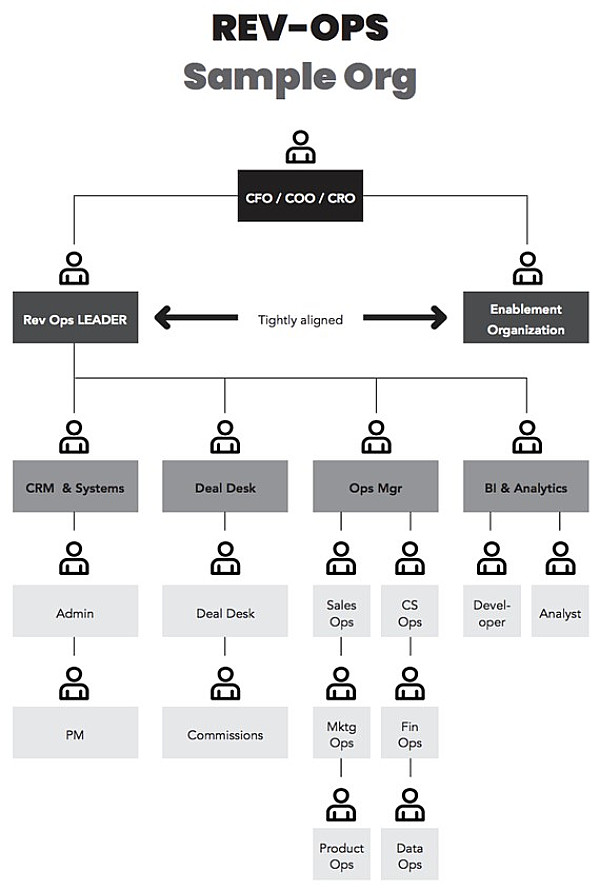At my company, we love running polls, so we ran one to see what CEOs and executive leaders think about revenue operations, or RevOps:

Yes, in the brave new world of Go-to-Market (GTM), together Sales, Marketing, and Customer Success function as a unified, high-performing revenue team with a silo-free focus on RevOps. Rather than trying to do everything as efficiently as possible for their individual departments, everyone works together to create an effective business model for the entire company.
To do that, they must work together well so they can discern where the company should be heading, what they should be investing in, what's working and not working, what systems are duplicates, and so on.
Think about it: How can you take the information you've learned about customers from Marketing and Sales and put it in the hands of Customer Success so they can figure out what's working and what isn't? How do you get the data about bad customers from Customer Success back to Marketing and Sales?
That two-way exchange of data is hard to pull off when your teams are siloed.
In fact, that difficulty might be the exact reason you feel stuck at a certain stage of your business maturity. It's also the reason Sales and Marketing are providing different numbers and contradictory data, then spending an inordinate amount of time trying to justify them rather than working from a single source of truth.
I call it the "who moved my cheese phenomenon." It's hysterical:
- "We've got the right data," Marketing says. "Our data is current."
- "No, our data says something different," Sales replies, "and it's more current than yours."
This is where the airplanes stall and drop from the sky. Or, more broadly, this is when your new airport terminal becomes a ghost town because customers aren't going there.
If you don't have a single source of truth by the time you get to the transition stage of GTM maturity—if your silos are still firmly in place—you're done for.
Creating a New RevOps Role
I propose that in the new world you knock the silos down and bring your teams together.
Create a new role—RevOps—to lead the operations team and have them report
to either the CFO or COO (possibly even the CEO) rather than any of the team leaders, so that the new revenue operations leader can act independently without any bias toward a specific function. Otherwise, the leader will tend to focus on his/her own department rather than overall business outcomes.
According to TOPO (now part of Gartner), "Revenue Operations is the modern operating model for driving efficient, predictable revenue by using an interconnected, observable, end-to-end process."
Here's what that new organizational structure might look like:

Although the revenue leader provides support for Marketing, Sales, and Customer Success, he/she needs to operate independently, and without bias toward any specific department, in order to be able to focus on the overall effectiveness of the business model.
That objectivity and alignment will allow the RevOps leader to answer questions such as the following:
- How do we create repeatable processes?
- How do we make sure our customer data is as clean as possible so we can determine what's working for which segments and why?
- How do we make sure our systems work the way they're supposed to so we can create more predictable and reliable data?
- What metrics should we use to measure our success in the market?
Of course, you don't want to lose efficiency. The focus on effectiveness doesn't have to come at the expense of being able to crank out landing pages, move data around quickly, build weighted forecasts, or launch NPS surveys. You still need a representative ops leader for each division of your revenue team, but it's all being done in the service of your business outcomes.
When done well, your new aligned revenue team—Marketing, Sales, and Customer Success—gains a perspective on the overall performance of the business, as well as the performance of individual teams so they can make decisions about where to invest next.
Imagine you didn't have each department bringing its own numbers into the boardroom so you then had to piece them together somehow to create an overall picture of the business.
What if, instead, you had a single leader, RevOps, which presented you with a scorecard that revealed the health of the business as a whole and at a glance?
You'd have a single source of truth.
Bear in mind that if you're in the ideation stage of business maturity, you might be just fine with only marketing ops and sales ops. After all, you're just getting off the launch ramp.
However, once you move into the transition stage, it becomes imperative that you bring Sales, Marketing, and Customer Success together as soon as possible. The success of your business will demand it.
Therefore, you should have revenue operations in mind even in the ideation stage.
Three Takeaways
So, how do you answer the question, "What do we need to operate effectively?"
- Unify and create a RevOps function to support Marketing, Sales, and Customer Success, and put the right elements into place.
- Identify and put in place a repeatable process that standardizes data, your systems and tech stack, and a set of metrics—no more conversation about who moved my cheese (i.e., where are my numbers).
- Run that process weekly at the executive level so you can help identify what the next move should be for your organization.
This article is based on excerpts from MOVE: The 4-Question Go-to-Market Framework.
More Resources on Revenue Operations
Revenue Operations: A Game-Changer for B2B Marketers
The Rise of Revenue Operations [Infographic]
Top 5 Predictions for the Future of Sales and Marketing Alignment [Infographic]




